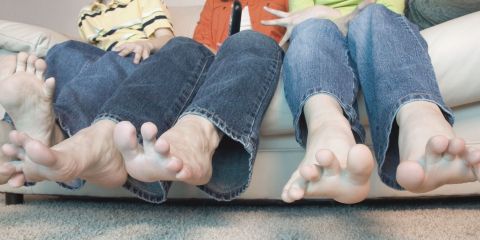Key Points
- W-sitting is when a child is sitting on the ground with their knees bent, their bottom on the floor, and their feet just outside of their hips, resembling a W.
- There a few proposed causes for w-sitting including structural abnormalities of the hips, weak core muscles and postural habits.
- W-sitting is not likely to be a problem unless its it is the primary sitting position and performed daily for a prolonged period of time
As a parent of a young child, you no doubt want the best for them in every way possible especially when it comes to their health.
Have you ever considered the impact of your child’s sitting position on their growth and development?
Walk into any preschool room and you’ll see some children sitting in what is referred to as a W-Sitting position; but what is W-sitting and is it good or bad?
This type of question is more common than you think and there is plenty of advice out there regarding this issue, both positive and negative. So, where do you begin? Let’s start with a general understanding of what exactly W-sitting is.
What is W-Sitting?
W-sitting is when a child is sitting on the ground with their knees bent, their bottom on the floor, and their feet just outside of their hips, resembling a W. The inside of their thighs can either be touching or apart.
What causes w-sitting? There a few proposed causes for w-sitting including structural abnormalities of the hips, weak core muscles and postural habits obtained from earlier moving stages such as crawling and kneeling.

Some children have a structural variance in their hip joint called femoral anteversion; where the neck of their femur is slightly rotated anteriorly, or forward, relative to the hip joint, causing a predisposition to w-sitting.
Another characteristic movement pattern that is affected by the internal rotation of the hip with w-sitting is standing with the toes pointed in, otherwise known as “pigeon-toed” gait and stance.

W-sitting can also be utilized to provide a greater base of support during sitting, which can be a compensation for weak core muscles or poor balance control during sitting. Behaviorally, the habits acquired from early movement patterns during a child’s development can also be attributed to habitual w-sitting.
What do the experts have to say about W-sitting?
According to some expert advice from pediatric orthopedic surgeons , w-sitting is really not that bad and shouldn’t necessarily be discouraged in children. In fact, some children early on possess an anatomical difference in their hip joint.
For children with femoral anteversion , w-sitting may actually feel more natural. They will eventually grow out of it as they continue to develop. The w-sitting position is also one that is used early on when an infant transition from crawling to sitting and standing.

As children learn how to move and interact with their environment, they also learn what positions are painful, and which are not. Young children are certainly more flexible and pliable than an adult and can sit in a variety of positions, including w-sitting, without placing excess stress on their joints.
Is there any research on w-sitting?
A research study conducted has demonstrated that daily w-sitting may have a negative effect on the standing posture of healthy infants aged 3-6 years. According to this study, with w-sitting on a daily basis there was increased forward tilt of the pelvis and hip internal rotation, which may increase the risk of developing orthopedic disease, possibly causing damage to the anterior cruciate ligament in the knee, the anterior hip labrum, or even the back throughout the growth process.
These processes were most notable only when the position was held as the primary sitting position and performed daily for a prolonged period of time. In some instances, the hip may even dislocate as a result of w-sitting, especially in cases of children with a diagnosis of hip dysplasia or joint hypermobility.
There are other reasons why w-sitting should be discouraged as well. When the hip or knee joint are bent like this, in order to assume this sitting position, it can cause the muscles to become short and tight. This can have detrimental effects on the development of gross movement patterns over time, possibly affecting their ability to move easily in a well-balanced and coordinated manner without pain.
The w-sitting position also hinders the development of trunk and core muscles by creating a larger base of support. This will decrease the muscle activation needed to sit upright and a child may have a difficult time sitting upright in other sitting and standing positions.
Why does this matter?
Why does this all matter? Prolonged periods of w-sitting over a long-time span can have negative consequences into adulthood.
With extended periods of W-sitting, there is an increased amount of stress on the hip and knee joints as well as kinetic changes down to the foot and ankle. This, once again, can lead to structural injury in each respective joint.
It is also known that W-sitting contributes to weaker core muscles that can lead to issues with back, hip, and pelvic floor pain over time. As we age, our hip range of motion and mobility decreases and will make sitting this way more uncomfortable and place even more stress on the hip joint itself.
W-sitting also widens a child’s base of support during sitting, which results in a decreased need for balance, postural control, stability and weight shifting as they are moving around and playing while in a seated position.
This can lead to poor balance and postural control during their development and may encourage slouching and poor posture as an adult. In addition to resulting in decreased trunk control, w-sitting does not require as much trunk rotation, which helps develop what is referred to as midline crossing and separation of the both sides of the body needed for symmetrical, bilateral coordination.
It is important to have good stability, trunk control and coordination in order to fully develop refined motor skills and hand dominance as a child.
Is there any link between Autism and W-Sitting?
There appears to be a link between autism and w-sitting .
Autism encompasses a wide range of symptoms and can vary amongst children. Across the autism spectrum there are some developmental delays, however autism is a neurological development disorder and is not diagnosed based on physical characteristics.
That being said, there are certain gross movement patterns and developmental delays that may alert further consideration into a diagnosis of Autism.
Although, w-sitting is not a direct correlation to Autism, it can be observed with developmental delays in gross motor control, balance, and stability. An autistic child may continue to sit in a w-sitting position far longer than an average child might, due to developmental delays in balance and core strength.
There is not much research related to this topic on account of the disorder not being diagnosed on physical characteristics alone. The observation of a child w-sitting might or could suggest a link to autism.
Solutions to W-Sitting
If you are concerned about your child w-sitting, there are several things that you can do to ensure that there are not negative long-term effects on their development:
- Encourage your child to sit in different positions throughout the day.
- Add core strengthening exercises to your child’s routine.
- Encourage hip stretching exercises
- Physical or Occupational Therapy

There are specialists and experts that will be able to assist you with all of the aforementioned strategies in both pediatric physical therapy and occupational therapy. If this is all a bit overwhelming, then breathe easy knowing that these healthcare providers are there to assist you.
Alternative Sitting Positions
- Long sitting sit with the knees extended and the hip flexed, with or without support for the back.
- Side sitting this position involves sitting with both feet out to one side of the body, in this position one hip would be rotated internally and the other would be externally rotated.
- Criss-Cross or Tailor sitting this common position involves hip flexion and externally rotating and abducting both hips so that your feet are crossed to opposite sides of your body.
- Sitting on a small bench.
Other non-sitting positions that can be used include squatting or lying face down on their stomach in a prone position.
*Please note that prolonged sitting in any of the aforementioned positions can have a detrimental effect on the growth, development, and health of joints, muscles, ligaments and tendons.
A variety of sitting positions should be taught and encouraged. It is also important to balance sitting with movement in general. Too much sitting will lead to tight, shortened muscles and joints and prohibit mobility later in life.
Helpful exercises
Exercise for young children doesn’t have to look like an adult exercise class with reps and sets and a variety of exercises grouped together.
Just moving around and playing is typically sufficient to ensure normal growth and development of strength, range of motion, mobility and balance.
If for one reason or another a child spends more time in one position such as w-sitting it is important to include stretches and strengthening exercises to correct for joint and muscle asymmetries and imbalances that occur with prolonged w-sitting.
Using w-sitting as an example, if the knees are bent and the hip is internally rotated, then the muscles along the back of the leg (most notably the hamstring) and the muscles that internally rotate the hip will be shortened and tight.
Therefore, it would make sense to perform stretches of the tight muscle groups. Imagine counteracting the position when encouraging stretches and daily exercises.
Stretches
Hamstring stretches- reaching for the toes with the legs out in front
Hip external rotation stretches- “Figure-4 stretch”
Hip flexor stretches- lunge, kneeling lunge, lying on the back and allowing the leg to extend off the bed.
As far as strength is concerned, with prolonged periods of w-sitting there will be abdominal and trunk extensor weakness as well as poor balance and stability. The best way for young children to develop good core strength is to just have them get out and play.
The following list of exercises can be done in a fun way so that your child doesn’t have to feel like they’re doing some forced exercise plan.
Core Strength Exercises/Activities
- Wheelbarrow walking hold your child’s ankles while they walk forward on their hands.
- Making Bridges your child lays on their back with their knees bent and feet flat on the floor, then they lift their butts in the air to make a bridge.
- Leg lifts standing and balancing on one leg while lifting the other knee toward the chest.
- Running
- Jumping
- Swinging (on their own).
- Jungle gym climbing
What does this all mean for my child?
While there is no official guideline on W-sitting and whether it’s good or bad, the main takeaway point is that children should be encouraged to sit and play in a variety of positions to facilitate adequate functional strength, mobility, and anatomic symmetry necessary to ensure healthy physical form.
If there anatomical differences present, instead of trying to force an uncomfortable sitting position on your child it may be helpful to try and correct the anatomical irregularities with a program of stretching and strengthening exercises to allow for greater mobility and access to pain free sitting in normal sitting positions.
There are a variety of sitting positions including long sitting, side sitting, criss-cross or tailor sitting, or sitting on a small bench that can be encouraged, as well as stretches and exercises that can be integrated into playtime.
Both Physical Therapists and Occupational Therapists are available to help with more advanced cases of postural weakness and anatomical asymmetries should they become necessary.
At the end of the day, the decision regarding how your child sits is up to you. There is information presented both for and against w-sitting.
Being a parent can be hard enough as it is and of course you’re always looking out for the best interests of your child.
Despite the mixed reviews of w-sitting and its implications on your child’s development, rest assured that your child will be most likely be just fine sitting this way for short periods of time, but it is far more important to emphasize a variety of sitting positions and to include adequate amounts of movement and playing to facilitate proper growth and development.
So, get out there and play with your kids! They will enjoy it and get all of the necessary physical attributes and proper growth they need.

